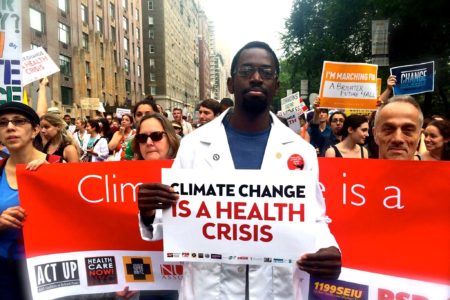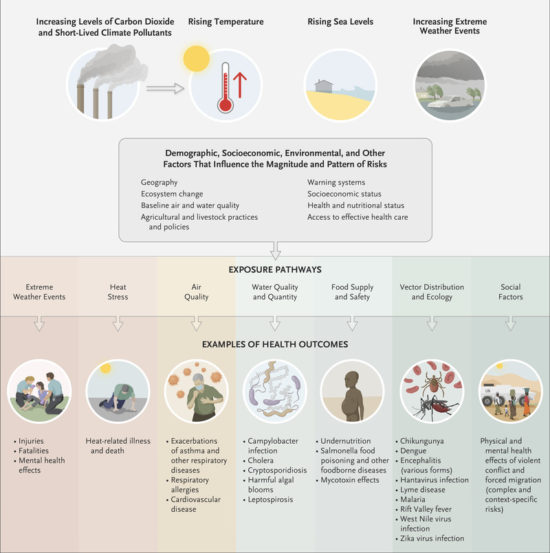October 11, 2019 – The New England Journal of Medicine (NEJM) has made health in a changing climate a priority by creating a portal and repository of articles for dissemination to healthcare professionals and the public. In an editorial found on the home page, it states, “as medical professionals navigate busy days in temperature-controlled hospitals…it can be easy to lose sight of the environmental chaos unfolding outside.”
To what environmental chaos is NEJM referring?
Climate change is impacting human health in numerous ways touching “every human organ system while challenging health organizations by interrupting supply chains and damaging public health infrastructure.”
Consequences include:
- more frequent heat-related illnesses from higher than normal daytime and nighttime temperatures.
- extreme weather events leading to a higher frequency of injuries and illness.
- more frequent incidents of allergies from changes in pollen distribution.
- increasing incidents of asthma.
- expanded ranges for insect-borne diseases.
And this new state of chaos is largely falling on the poor, the young, and the elderly with the countries most impacted the least responsible for the carbon pollution that is creating the harm.
The editorial notes that action is needed to reduce the chaos by addressing the causes of the climate change we are already experiencing and will be inflicting on the generations that follow. It calls for large-scale climate action in the medical community to provide the healthcare that is needed while developing “bold interventions to avert the most catastrophic outcomes.”
To give you the flavour of the site I refer to three articles appearing there which provide the following:
- a discussion on the relationship between air pollution and mortality in 652 cities,
- a look at strategies for the healthcare industry to combat Environmental Protection Agency rollbacks under President Donald Trump,
- and epidemic preparedness in the face of climate change, political instability and conflict.
What is interesting is just how NEJM has gone back in its archives on the subject of health and the environment with listings dating from 1956. On that date an article looked at the air quality challenges in cities like London and Los Angeles and described measurement, testing, and mitigation strategies. In a read of the article, even back then carbon pollution, ground-level ozone, and other airborne pollutants from the burning of fossil fuels were a growing health concern.
A nice feature is NEJM’s interactive graphic where you can explore and learn about greenhouse gases, climate drivers, and exposure pathways showing how each of these subjects impacts human health and healthcare delivery.
NEJM reports that the global health costs of climate change and fossil-fuel driven air pollution are estimated to be trillions of dollars. Every extreme weather event adds billions in costs to local healthcare delivery. The site also provides learning materials on:
- how fossil-fuel combustion and exposure to particulate matter from the associated air pollution poses a major risk for cardiovascular and heart disease and stroke.
- how higher temperatures and ongoing ozone depletion increases the risk for skin cancers, and other dermatological conditions.
- how risks for gastrointestinal diseases and waterborne illnesses are related to climate change.
- how malaria, dengue, Lyme disease, West Nile virus, cholera, and cryptosporidiosis are being influenced strongly by climate change.
- how the existential threat of climate change and witnessing alterations to the environment are having repercussions for mental health, and exposure to such adverse effects as extreme weather events are increasing the risk of mental health problems.
- how carbon dioxide emissions are affecting human nutrition by altering quantity, and quality of crop yields, reducing plant levels of protein, zinc, and iron.
- how extreme weather, severe heat, and exposure to air pollution is disrupting maternal health impacting pregnancy outcomes from spontaneous abortion, to low birth weight, preterm birth, and increases in neonatal mortality.
- how children under age 5 are being negatively impacted by climate change and air pollution with heightened risk for disease associated with heat, extreme weather, and water and vector-borne pathogens.
- how wildfire smoke, extreme heat, particulate matter, and ground-level ozone are exacerbating respiratory diseases, and allergies.
- how extreme heat is contributing to renal failure, electrolyte imbalances, and kidney stones.
- how extreme weather events contribute to acute physical injuries, housing insecurity, and psychological trauma.
- and how extreme heat is linked to increased aggression and violence, war, and forced migration.
The interactive tool also provides suggestions for healthcare systems to combat climate change impacts looking at climate resiliency, evidence-based adaptation, disaster preparedness, training, and education. In s section that looks at the industry’s own carbon exposure, it notes the sector’s carbon footprint, estimated at 10% of the total greenhouse gas emissions of the United States annually, and compares the results to the entire United Kingdom which produces less.
For healthcare administrators, medical practitioners, this NEJM site should be a must-read. And for the public, it is a timely and welcome resource for understanding climate change and its direct impact on all of us. I highly recommend dipping into it and would love to hear comments from readers on how they can use the site for climate change advocacy.

















